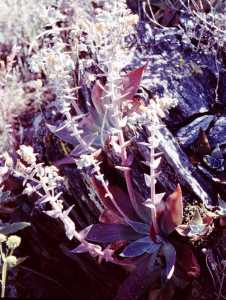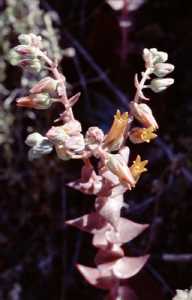Dudleya arizonica
|
|
|
|
Family: Crassulaceae
Arizona Live-Forever, more...chalk dudleya, cliff lettuce (es: siempreviva)
[Dudleya pulverulenta subsp. arizonica (Rose) Moran] |
ROSETTES: solitary, subsessile, 0.5-2(-6) dm wide, of 10-40 leaves, on stems 1-4 cm thick. LEAVES: glaucous to chalky, sometimes red in age, oblong to oblong-obovate, broadly acute to mostly long-acuminate, 3-17(-30) cm long, 1-5(-10) cm wide, 2-4(-9) mm thick, the base 1-3.5(-6) cm wide. FLORAL STEMS: 1.5-6 dm tall, 2-6 mm thick, red, the 5-20 leaves spreading, cordate-ovate, acute to acuminate, the lowest 1-3.5 cm long, 0.5-2.5 cm wide. CYMES: of 3-6 usually ascending branches 4-27 cm long and 4-20-flowered; pedicels mostly erect or ascending, 0.5-1.5 cm long, often bending sharply upward in fruit. FLOWERS: sepals 3-6 mm long; corolla apricot-yellow to mostly deep red, 9-15 mm long, the tube 4-8 mm long. 2n = 34. NOTES: Dry rocky slopes and cliffs of desert mts.; Maricopa, Mohave, Pima, Pinal, Yuma cos.; 150-800 m (500-2700 ft); mostly Apr-Jun; s NV, sw UT, se CA; Baja C. Norte, nw Son., Mex. REFERENCES: Moran, Reid. 1994. Bixaceae. J. Ariz. - Nev. Acad. Sci. Volume 27, 190-194. Caudices simple, 1-15 × 1-4 cm, axillary branches absent. Leaves: rosettes solitary, not in clumps, 10-35-leaved, 5-30(-60) cm diam.; blade ± chalky white, in age often red, oblong to oblong-obovate, 3-17[-30] × 1-7 cm, 2-4 mm thick, base 1-3.5 cm wide, apex acute or usually long-acuminate, surfaces not farinose, chalky. Inflorescences: cyme 3-6-branched, cylindric; branches (mostly ascending), twisted at base (flowers on underside), simple, (3-7 cm wide); cincinni 2-5, 4-20-flowered, circinate, 4-27 cm; floral shoots 15-60 × 0.2-0.6 cm; leaves 5-25, spreading, cordate-ovate to almost deltate, 10-35 × 5-25 mm, apex acute to acuminate. Pedicels mostly erect or ascending from bud to fruit, rarely spreading to pendent, in fruit often bent upward near or above middle, 5-20 mm. Flowers: calyx 4-7 × 4-7 mm; petals connate 4.5-8 mm, red to apricot yellow, 9-15 × 1.5-2 mm, apex obtuse to sharply acute, tips outcurved; pistils connivent, erect. Unripe follicles erect. 2n = 34. Flowering spring. Dry, rocky slopes and canyon walls in desert mountains; 100-1100[-1500] m; Ariz., Calif., Nev., Utah; Mexico (Baja California, Sonora). The diploid Dudleya arizonica is closest to the diploid D. pulverulenta, looking like a reduced desert form, smaller in most parts, or sometimes like a seedling. Northward, the ranges are well separated, and southward in Baja California, where both are more sporadic, the ranges and the plants seem mainly distinct. Southward, D. pulverulenta makes large plants like those in the far northern part of its range, whereas southward D. arizonica generally is smaller and less like D. pulverulenta and more like just any old dudleya. In eastern San Diego County, California, the two intergrade and it is hard to draw a line between them. In coastal San Diego County, California, the type region, plants of D. pulverulenta are generally smaller and less extreme than those to the north and south and a little more like D. arizonica. For these reasons, I formerly treated D. arizonica as a subspecies (R. V. Moran 1943b), and something may still be said for that treatment. Because they are generally quite different through much of their broad ranges, it seems better to treat them as different species. The inflorescence of Dudleya pulverulenta and D. anthonyi Rose is approached in some plants of D. arizonica. The mostly ascending branches are sometimes twisted at the base, putting the flowers on the abaxial side, the flowers are sometimes spreading or even pendent, and the fruiting pedicels commonly are more or less bent upward. Because the leaves are fewer and, with the thinner caudex, narrow at the base, seedlings of D. pulverulenta may closely resemble adult plants of D. arizonica.
FNA 2009, Jepson 2012, Kearney and Peebles 1969 Duration: Perennial Nativity: Native Lifeform: Succulent General: Succulent perennials, caudex to 50 cm tall, stems simple, axillary branches absent, herbage whitish and glabrous throughout, covered with a dense, mealy powder or chalky wax, the fleshy stems, leaves, and leafy inflorescences arising from a thick basal rosette. Leaves: Alternate, basal forming large, solitary and dense basal rosettes, the rosettes 30-80-leaved, 25-60 cm in diameter, blades chalky white, oblong to oblong-oblanceolate, widest at base or in the uppermost (distal) one-third, 8-30 cm long, 3-13 cm wide and 3-10 mm thick, bases 3-8 cm wide, apices acuminate or tipped with a short, sharp, abrupt point (cuspidate), surfaces puberulent and chalky, sessile or short-petiolate, basal blades withering in early summer. Flowers: Red, pendent, inconspicuous and covered by thick, bract-like leaves, petals 5, 11-19 mm long and 2-4.5 mm wide, connate or fused at base for 6-10 mm and erect to spreading above, apices acute to obtuse with erect tips, sepals waxy, calyx 5-9 mm long and 5-8 mm wide, pistils converging and erect, stamens 10, carpels 5, inflorescences in dense, 2-5 branched cymes, obpyramidal to cylindric in outline, branches twisted at base with the flowers on the underside, simple or divided into 2 forks, these with 2-5 tightly coiled (circinate) or scorpoid-like (cincinni), becoming straight and spreading to erect with age, 10-30-flowered, 10-50 cm long, floral shoots to 1.5 m long and 0.5-2 cm wide, pedicels pendent or declined, in age sharply bending near middle to bring fruits erect, 10-35 mm long. Fruits: Whorls of follicles, each follicle dehiscent along an adaxial suture, unripe follicles erect. Seeds 1-20 or more, brown, narrowly ovoid, longitudinally and finely cross-ribbed. Ecology: Found on rocky cliffs, dry hillsides, and the coastal side of mountains, in canyons, from 0-5,000 ft (0-1524 m); flowering early summer. Distribution: California; Mexico. Ethnobotany: Specific uses for the subspecies are unknown, but the species has uses; fleshy leaves used to remove corns and calluses, decoction of roots taken for asthma, and leaves chewed, with or without salt, by children. Etymology: Dudleya is named for William Russel Dudley (1849-1911), first professor of botany and head of the Botany Department at Stanford University, pulverulenta means powdery, dust-covered, and arizonica means of or from Arizona. Synonyms: Dudleya arizonica, Dudleya lagunensis, Echevaria arizonica, Echevaria lagunensis Editor: LCrumbacher2012 |



